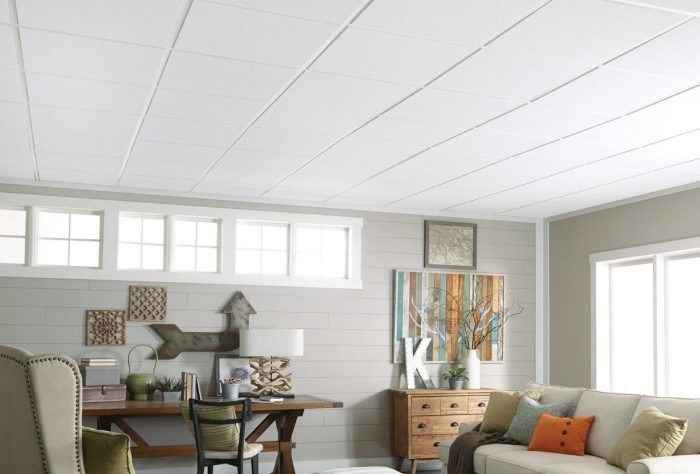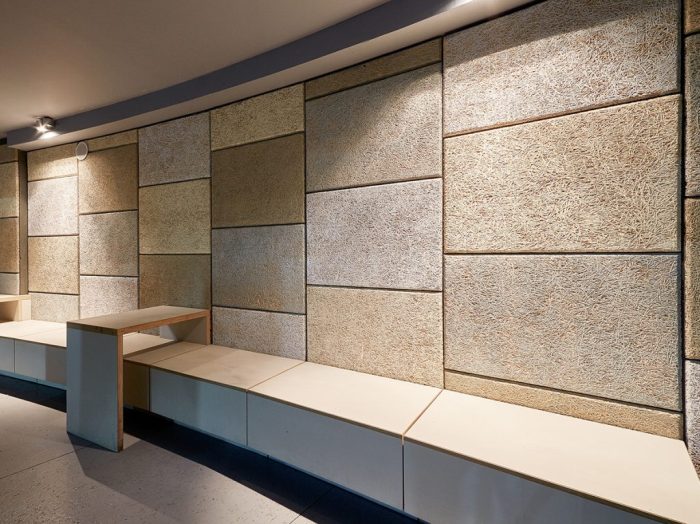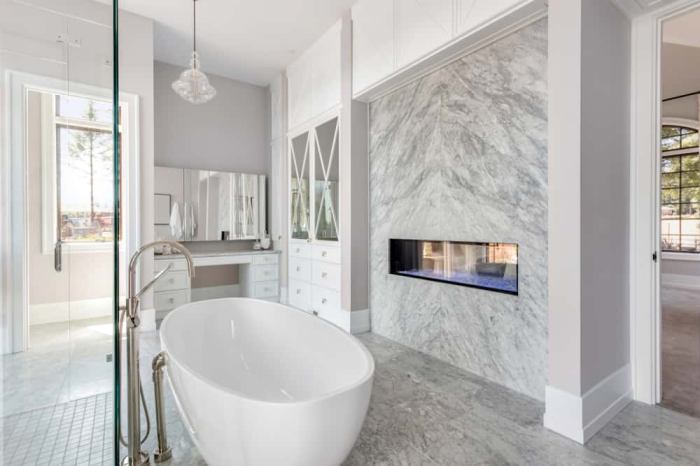Imagine stepping into a private bathroom sanctuary where tranquility reigns supreme, and the cacophony of daily life melts away. This oasis of calm can be achieved with the strategic use of soundproof tiles, a game-changer for those seeking respite and privacy in their most personal spaces.
In this comprehensive guide, we delve into the world of soundproof tiles for private bathrooms, exploring their benefits, materials, design techniques, aesthetics, maintenance, and more. Whether you’re a seasoned homeowner embarking on a DIY project or seeking professional guidance, this guide will equip you with the knowledge and inspiration to transform your bathroom into a haven of tranquility.
Soundproofing Benefits
Incorporating soundproof tiles in private bathroom spaces offers a range of acoustic advantages, significantly enhancing privacy and tranquility.
The tiles are engineered to absorb and dissipate sound waves, reducing noise levels and creating a more peaceful environment. This is achieved through their unique composition, which features materials that effectively dampen sound vibrations.
Noise Reduction
Soundproof tiles effectively reduce noise pollution from various sources within the bathroom, such as running water, flushing toilets, and conversations.
By absorbing sound waves, the tiles minimize their transmission through walls and floors, preventing noise from disturbing adjacent rooms or creating echoes within the bathroom.
Privacy Enhancement
Soundproof tiles enhance privacy by minimizing the transmission of sound beyond the bathroom space.
This is particularly beneficial in multi-occupant households or shared living situations, as it prevents private conversations or sensitive activities from being overheard.
Echo and Reverberation Minimization
Soundproof tiles play a crucial role in minimizing echo and reverberation within the bathroom.
Hard surfaces, such as ceramic tiles and glass, tend to reflect sound waves, creating echoes and reverberation that can make it difficult to hear clearly or create a sense of discomfort.
Soundproof tiles absorb these sound waves, reducing echo and reverberation, resulting in a more pleasant and comfortable acoustic environment.
Material Considerations
Selecting the optimal material for soundproof tiles in private bathrooms necessitates an understanding of the available options and their respective advantages and disadvantages.
The density and thickness of the material play a crucial role in determining its soundproofing capabilities. Denser and thicker materials tend to offer superior sound absorption and insulation.
Acoustic Foam
- Lightweight and easy to install
- Excellent sound absorption
- May not be as durable as other materials
Fiberglass
- Durable and moisture-resistant
- Good sound absorption and insulation
- Can be irritating to skin and eyes
Mass-Loaded Vinyl (MLV)
- Thin and flexible
- Excellent soundproofing against low-frequency noise
- May be difficult to handle and install
Design and Installation Techniques
Designing and installing a soundproof tile system for private bathrooms requires careful planning and attention to detail. By following these guidelines, you can create a quiet and relaxing space that minimizes noise pollution.
Optimal tile placement involves strategic positioning to maximize sound absorption and minimize sound transmission. Tiles should be installed on all surfaces, including walls, floors, and ceilings. Avoid leaving any gaps or openings that could allow sound to leak through.
Tile Spacing and Sealing
Proper spacing between tiles is crucial for effective soundproofing. Use spacers to ensure consistent gaps between tiles, allowing for sound absorption. Seal all joints and edges thoroughly using acoustic sealant to prevent sound leaks.
Avoiding Sound Leaks and Flanking Paths
Sound leaks can occur through even the smallest gaps or openings. To prevent this, seal all penetrations, such as pipes, vents, and electrical outlets, using acoustic sealant or caulk. Flanking paths refer to alternative routes for sound to travel around soundproofed areas.
Avoid creating flanking paths by ensuring soundproofing measures are continuous and complete.
Aesthetics and Customization
Beyond their soundproofing capabilities, soundproof tiles offer a range of aesthetic options to complement any bathroom décor. From classic neutrals to bold patterns, these tiles allow for personalized designs that blend seamlessly with existing fixtures and finishes.
Color plays a significant role in the overall ambiance of a bathroom. Light colors, such as white, beige, or light gray, create a sense of spaciousness and tranquility, while darker shades, such as navy, emerald green, or charcoal, evoke a more dramatic and sophisticated atmosphere.
Textures and Patterns
Textures and patterns add depth and interest to bathroom walls. Textured tiles, such as those with a stone-like or linen-like finish, create a tactile experience and can help conceal imperfections in the walls. Patterned tiles, such as those with geometric designs or intricate mosaics, add a touch of personality and can become the focal point of the room.
Customizations
Soundproof tiles can be customized to create unique and visually appealing spaces. By combining different colors, textures, and patterns, homeowners can create custom tile patterns that reflect their personal style. Additionally, some manufacturers offer the option to print custom designs or photographs on soundproof tiles, allowing for truly bespoke bathroom designs.
Maintenance and Durability
Maintaining soundproof tiles in private bathrooms is essential to ensure their longevity and effectiveness. Regular cleaning is crucial to prevent moisture damage and the accumulation of dirt and grime that can compromise their soundproofing capabilities. Use a soft cloth or sponge with mild soap and water to clean the tiles, avoiding harsh chemicals or abrasive cleaners that could damage the surface.
Durability
The durability of soundproof tiles varies depending on the material used. Ceramic tiles are generally durable and resistant to wear and tear, while fiberglass tiles are lightweight and flexible, making them less susceptible to cracking or breaking. Vinyl tiles are also durable and easy to clean, but they may be more prone to scratches and dents.
When selecting soundproof tiles for a private bathroom, consider the intended use and the durability requirements of the space.
Case Studies and Examples
Numerous successful soundproof tile installations in private bathrooms attest to the effectiveness of these solutions. These case studies showcase diverse design approaches and material choices, demonstrating the transformative impact of soundproofing on bathroom acoustics.
Before-and-after comparisons provide tangible evidence of the noise reduction achieved. In one instance, a bathroom with a tile floor and untreated walls generated a noise level of 55 decibels (dB). After installing soundproof tiles on the walls, the noise level dropped to 40 dB, a significant improvement that transformed the bathroom into a more tranquil space.
Different Design Approaches
Design approaches vary based on the desired aesthetic and functional requirements. Some homeowners opt for seamless installations, where soundproof tiles blend seamlessly with the existing bathroom décor. Others prefer contrasting tiles to create a focal point and enhance the room’s visual appeal.
Material Choices
Soundproof tiles come in a range of materials, each with unique properties. Acoustic foam tiles offer excellent sound absorption and are lightweight and easy to install. Vinyl soundproof tiles are durable and water-resistant, making them suitable for wet environments like bathrooms.
Mass-loaded vinyl (MLV) tiles are highly effective at blocking sound transmission and can be used as an underlayment beneath other tiles.
DIY vs. Professional Installation
Soundproofing tiles can be installed as a DIY project or by hiring a professional installer. Both options have their advantages and disadvantages.
DIY Installation
Advantages:
- Cost-effective: Installing soundproof tiles yourself can save money on labor costs.
- Flexibility: You can work at your own pace and schedule.
- Control: You have complete control over the installation process and the final result.
Disadvantages:
- Time-consuming: Installing soundproof tiles can be a time-consuming process, especially if you have a large area to cover.
- Difficulty: Installing soundproof tiles requires some technical skills and knowledge.
- Mistakes: If you make a mistake during installation, it could compromise the soundproofing effectiveness of the tiles.
Step-by-Step Guide for DIY Installation:
- Prepare the surface: Clean the surface where you will be installing the tiles and make sure it is smooth and level.
- Apply adhesive: Apply a thin layer of adhesive to the back of the tiles.
- Install the tiles: Press the tiles into place and hold them for a few seconds to ensure they adhere properly.
- Grout the tiles: Once the tiles are installed, apply grout to the joints between them to fill in any gaps and create a smooth surface.
- Seal the tiles: Apply a sealant to the tiles to protect them from moisture and dirt.
Professional Installation
Advantages:
- Expertise: Professional installers have the experience and knowledge to ensure a proper installation.
- Time-saving: Hiring a professional can save you time and effort, allowing you to focus on other tasks.
- Warranty: Many professional installers offer warranties on their work, giving you peace of mind.
Disadvantages:
- Cost: Hiring a professional installer can be more expensive than installing the tiles yourself.
- Availability: Professional installers may not be available on your desired schedule.
- Control: You have less control over the installation process and the final result.
When to Hire a Professional Installer: Consider hiring a professional installer if:
- You have a large area to cover.
- You are not comfortable installing the tiles yourself.
- You want a warranty on the installation.
- You have a complex installation, such as installing tiles on a curved surface.
Cost Considerations
Soundproof tile installation costs vary depending on several factors, including:
- Material choice: Soundproof tiles can be made from various materials, such as fiberglass, rubber, or vinyl. The material’s density and thickness affect its soundproofing capabilities and cost.
- Tile quantity: The number of tiles needed for the project will impact the overall cost.
- Labor costs: Installing soundproof tiles requires specialized skills and equipment, which can affect the labor costs.
Tips for optimizing value and minimizing expenses:
- Compare quotes from multiple contractors: Get estimates from different contractors to find the best price for your project.
- Consider DIY installation: If you’re handy and have some construction experience, DIY installation can save you labor costs.
- Look for sales and discounts: Some retailers offer discounts on soundproof tiles, especially during off-seasons.
- Consider the long-term value: Soundproof tiles can improve your privacy and comfort, which may be worth the investment in the long run.
Final Conclusion
Incorporating soundproof tiles into your private bathroom space is an investment in serenity, privacy, and overall well-being. By carefully considering the materials, design, and installation techniques Artikeld in this guide, you can create a sanctuary where you can truly unwind and recharge.
Remember, a soundproof bathroom is not just a room with reduced noise; it’s a sanctuary where tranquility and privacy prevail.



